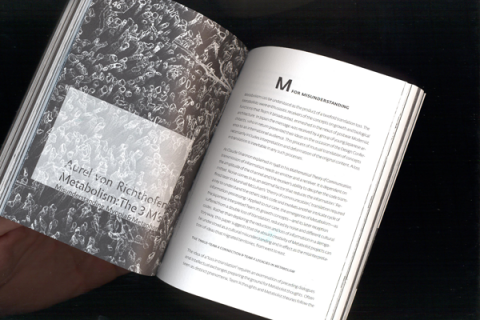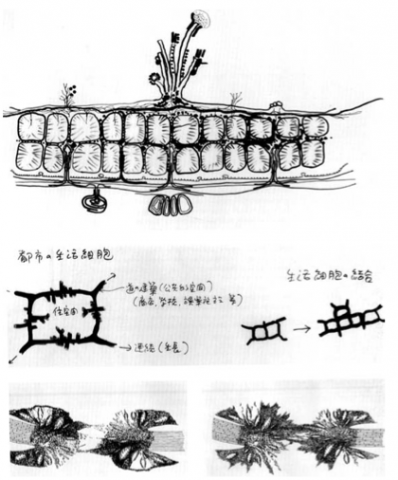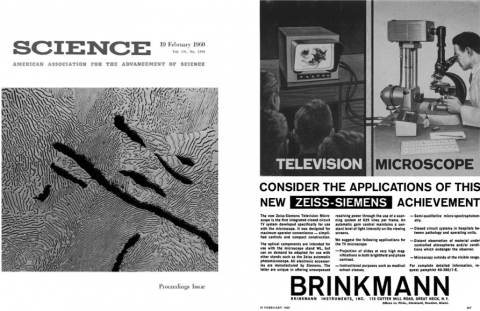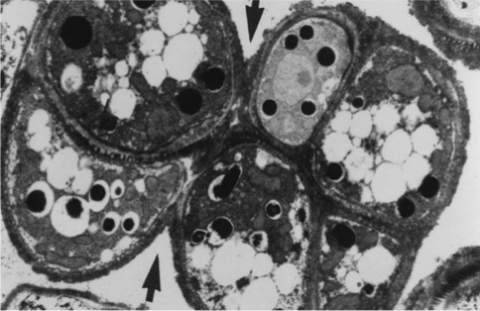- AURELVR
- DESIGN
- RESEARCH
- TEACHING
3m’s of Metabolism

M for misunderstanding
Metabolism can be understood as the product of a twofold translation loss. The Metabolists were enthusiastic receivers of the concepts on growth and biological functions that Team X broadcasted, enmeshed in the nexus of post war Modernist architecture. In Japan the message was received by a group of young Japanese architects, who in return presented their ideas on the occasion of the Design Conference to an international audience. This process of mutual translation of concepts necessarily includes interpretation and deformation of the original content. A loss in translation is inevitable in any such processes.
As Claude Shannon explained in 1948 in his 'Mathematical Theory of Communication', transmission of information needs an emitter and a receiver. It is dependent on the amplitude of the channel and the receiver's ability to decipher the code transmitted. Noise comes in as external factor that reduces the information.i Refined later in Marshall Mc Luhan's 'theory of communication' translation required a key to understand the others side's code and involves another intricate cycle of information processing.ii Applied to our case, the emergence of Metabolism -as the Japanese interpreted Team X's growth concepts- and the later reception suffered from a double loss of translation, reduced by noise and different cultural codes. Rather than deploring the reduction and loss of information in a derogatory way, this paper suggests that the absurd creativity of Metabolist projects can be understood as a cultural misunderstanding and in effect as the misinterpretation of ideas that migrated territories, from west to east.
_The Tange - Team X connection & Team X legacies in Metabolism.
The idea of a "loss in translation" requires an examination of preceding dialogues and intellectual exchanges preparing the ground for Metabolist thoughts. Often seen as distinct phenomena, Team X thoughts and Metabolist theories follow the same investigations on 'growth and change' of architecture and urbanism. The figure of Kenzo Tange stands out in this discourse, linking both cultures. In his double role as delegate to the west and mentor to the east, he holds the position of an ambassador and mediator. Tange was the Japanese CIAM and later Team X representative. He had attended the CIAM congresses in Aix-en-Provence and Dubrovnik where he presented his plan for Tokyo, a mega structure spanning the totality of the bay providing for 10 million inhabitants. Tange was an active participant at these congresses and his disapproval with the dissolution of CIAM hints at his commitment to the cause.iii Together with Maki he published the essay "On Group Form" directly connected to late CIAM and Team X directions:
"We believe that the concept of group form we are now proposing will be one of the most vital methods in this respect. For although we are conscious of the architectural development of the individual buildings that are elements of the group, we try also to create a total image through the group, that is again a reflection of growth and decay in our life process. This is an effort to conceive a form in relationship to an ever-changing whole and its parts."iv
Frustrated that the questions of "growth and change" were far from being resolved, Tange postulated Metabolism as a new philosophy of change. The Metabolist reception of the "organic" and its adaptation to the specific conditions of Japan will be the first operation of translation - from west to east - linked to a loss of information. [Figure_01: Maki, Ohtaka: Conceptional From, Mega Form, Group Form 1970]
_Japanese urban congestions of the 1960s
By 1962, Tokyo's population reached ten million. Following Mexico City, Tokyo was outrageously growing by the day confined within the borders of a congested urban space and thus generating a particularly uptight metropolitan condition. In a country ten times as densely populated as the United States, the spatial needs of Tokyo's metropolitan region were of outmost national concern.v In parallel, the daily flux of commuters would push the city's infrastructures to its furthest limits. While Team X members envisioned their concepts on the backdrop of post-war western cities, relatively small in scale, the Tokyo condition seemed like the frightful future extrapolation of their concerns and worries. Calling for immediate solutions to these dystopian circumstances, the Metabolists envisioned the accelerated flows of population, materials, and information accommodated in complex infrastructural systems that would integrate the latest technological advancements and regenerate in "metabolic" cycles.
Compared to the Athens CIAM Charter that promoted the segmentation of everyday activities into distinct sectors, Metabolist rhetoric demanded a more seamless, accelerated socio-architectural organicism. As they state: "We are trying to encourage the active metabolic development of our society through our proposals."vi Initially, Tange tried to stress Metabolism's flexibility and openness. In his eyes, the late twentieth century city was "not merely a collection of people and functions, but an open complex linked together by a communication network." Its function was no longer the production of objects, "but to act as a brain center performing countless invisible tasks."vii Team X's biological metaphors on "growth and change" were broadened on their voyage to the east. The Metabolists were now to collapse organic functions with communication networks as one unilateral condition of urbanity, understanding both systems as information driven and therefore interrelated constitutional elements for urbanism. [Figure_02: Kisho Kurokawa, Tokyo Helix City Project, published in Kenchiku Bunka 1967]
M for myopia
Metabolism was myopic in the sense that it brought to the foreground microscopic imagery as a backdrop for macroscopic projects. By a process of zooming in and zooming out the Metabolists blew out of proportion images from the micro-world through usage of new microscopes. In fact, Metabolist architects excitedly used a new visual instrument: the SEM scanning-electron-microscope (SEM). The discovery of metabolic functions was not new to the sixties, but the fact that advances in microscopy rendered these functions visible for the first time reclined a fascination with ideas of growth and the sustenance of life.
But before entering a conversation on the Metabolists optical toys, we need to examine Metabolism through its initial transference from the world of biology. In effect, metabolism refers to the sum of the physical and chemical changes that take place in living organisms. The process was discovered and described in France in the late eighteenth century by Antoine-Laurent Lavoisier, who was the first to understand the reaction of oxygen inside living organisms and basic principles of energy production in cells.viii The concept provided a fundamental understanding of chemical and physical reactions, separate from the world of "life", that allowed the explanation in parts, of underlying principles of biology, of lie itself. In the biological sense, metabolism can be summarized in the uptake and distribution of chemical compounds within the body, the biotransformations undergone by such substances, and the elimination of the compounds and their metabolites.ix
The opposition of "life" to "non-life" is key to understanding how biological terms, "metabolism" among others, were transposed to the realm of architectural design. While western architecture is typically described in terms of statics, mechanics and other inanimate qualities Metabolist architecture is conversely described in terms of "life". Metabolist architecture is perceived in regenerating cycles of emergence, growth, use, decay and destruction. It is engaged in a rigorous discussion with issues such as energy consumption and the transformation of materials, as well as their manipulation in transitional states. These overlapping microcosmic cycles define the Metabolist city. These cyclic transitions include both synthesis- anabolism - and breakdown-catabolism - of the bodies constituents. In the living organism these are the physical and chemical changes that take place in a given chemical substance.
Architecture, in the Metabolist logic, is perceived as a system that builds up from constituent parts hence the cell analogy: to synthesize an adaptable, changeable and flexible total. The reverse process of breakdown or recycling closes the circle. In this sense, Metabolism offers a radically different perception of architecture: what was previously a linear development now becomes a cyclical one. Metabolism unfolded architecture's destructive possibilities, formulating its own self-destruction as a critique of CIAM's unquestioned belief in progress.
_Metabolism's latest toy: the scanning-electron-microscope.
The emergence of the Metabolist movement coincided with the development of medical and scientific innovations in the natural sciences. 1960 marks not only the year of the World Design Conference in Tokyo, but also the proliferation of a new kind of medical imagery. Metabolism used to its advantage this new visual material as a backdrop to underline and articulate its position. This visual borrowing was functioning along the lines of a modernist lineage that visually captured another field of research and transposed it to the realm of architecture. In a similar way that Modernists linked and equated architecture to engineering, Metabolists generalized architecture as a science of life that incorporated biology. Triggering a visual language incorporating the new medical images this strategy underlined Metabolism's futuristic aspirations.
The scanning-electron-microscope (SEM) was the first invention of many medical innovations aiding the observation of life at high resolution. Invented in 1931 by Max Knoll and Ernst Rushka in Germany, SEM magnified objects 8,000 times far surpassing classical light microscopes.x By 1959, a number of instruments were available using stereo-scanning and thermo-ionic emitters that would achieve a resolution of 10 nm, or a magnification of a million times.xi The birth of the SEM was often called as the "beginning of modern cell biology", since classical cell biology relied on ordinary light microscopes that were physically incapable of resolving the fine structure of a cell.xii[Figure_03: SEM image of a cell cluster, human nervous system under radioactive contrast substance, published by Kisho Kurokawa in Kenchiku Bunka, Nov. 1967]
_Capsules and structures: It's all in there.
The scale resolution of SEM provided pristine images of the actual cell content, marking a shift in the perception and representation from the modern to the Metabolist cell. On the one hand, the modern cell highlighted the enclosure of space, embodied in the use of steel and glass, leading to the invention of the curtain wall. Freeing the wall from its load-bearing functions allowed enclosure elements to be perceived as membranes. This perception of space as a bounding membrane was in direct correlation with microscopic images of the time that, due to physical restraints of light-microscopy, showed cells only from the "outside". While the shape of the cell and its membrane were visible, the inner organization and structure remained blurred, and therefore invisible. The metabolic processes within cells were hidden from the scientific eye. In this sense, the modernist cell relied on an abstract and spatial condition, where interior functions were indeterminate and blurry. On the other hand, with the advent of SEM imagery the different functions of a cell became visible. Structures such as the Golgi apparatus, the cell nucleus, and the non-homogenous texture of the cell membrane could be seen in detail for the first time. Directly reflecting these emerging visual discoveries, the Metabolist cell advanced to a much more equipped version of the cell. Even though some critics see Buckminster Fuller's cell, patented in 1937, as the direct predecessor of Metabolist cells, the reading and the availability of detailed cellular microscope images offered a more complex understanding of the cellular system. Metabolist cells were now articulated with precision and detail. Their differentiated space membrane accommodated different functions for daily activities. In a similar way the interior of these cells and capsules was highly organized; every function was translated one-by-one into architectural components.
For instance, one may find in Kurokawa's "Capsule Tower" niches for different activities. Bathrooms and kitchens are parts of the wall partitions' variable thickness. Doors and windows become the regulating mechanism of the cell membrane. Beds are extruded from the floor. Walls are highly equipped with media, heating, ventilation and air-condition systems. Overall, the membrane of the capsule transforms into niches that accommodate advanced electronic communication and entertainment, sanitary and culinary activities. [Figure_04: Kisho Kurokawa,capsule detail for Capsule Tower, 1971] In a similar way, SEM imagery triggered a shift in the perception of urban infrastructures. While Team X urbanists played extensively with "organic" schemes, such as Alison and Peter Smithson's plan for Berlin in 1957, these schemes developed a phenotypic approach to the "organic". Growth was mimicked in attempts to render a flexible organizational scheme. As with the modernist cellular space, the activities within that urban space were rendered as potentials within an abstract blank space. In contrast, Metabolism's gaze inside the cell opened up a universe of elements and structures that visualized exactly these activities, interrelations, networks and patterns. Kurokawa extracted a range of elements from these biological images and transposed them into architecture. He classified porous spaces and fiber forms, distilled from an array of biological patterns. Eventually Kurokawa, after interpreting and sorting out the SEM imagery, came up with a classification of animals versus plants: he described heterogeneous metaphoric, membranous and master-space systems as animal-like and homogenous, information-like, linear, infrastructural systems as plant-like.xiii Essentially, SEM images guided Metabolists to find what they were looking for just beyond the horizon of earlier modernist cell perception. [Figure_05: Kisho Kurokawa, Porous and Fibre Form,in Kenchiku Bunka, Nov. 1967]
M for metaphor
_From Nature magazine to Japan Architect
In 1959, Nature magazine printed an image of a metabolic cluster with an overwhelming range of organic cells and structures. This image was of such striking visual effect that one could even argue that SEM microscopes had destabilized the previous limits of human visual imagination. The microscopic view into organisms unfolded an extraordinary universe; through the microscopic gaze it was possible to distinguish the DNA double helix, the cellular systems and its different functions, the cellular nucleus, the golgi-apparatus, fibers and even intervascular fluids. Biological network connections were portrayed for the first time, while the resemblance of cells to geodetic domes and of fibers to infrastructural arteries, was so effortless that it offered a whole new visual territory for design. [Figure_06: Scanning-Electron-Microscope Image, Nature Magazine January 1959] Encapsulating the ideas of Metabolism, this image was appropriated by Kisho Kurokawa, who used it as an introductory visual analogue for his Metabolist ideas in Japan Architect.xiv Projected onto architecture and urbanism, metabolism served as a metaphor to understand phenomena in overgrowing cities like Tokyo in 1960. The fact that no member of the Metabolist group was directly involved in natural sciences or medicine underscores that the translation process remained at an amateur level. Still, the analogy to biology offered a series of alluring parallels. The city was perceived as a living organism and, as such, it was subject to cyclical phases of life: birth, growth, decay and death. The city was constituted out of different functional parts. The smallest unit in that system was the cell, in itself a living organism, subject to the same cyclical phases on a smaller scale.
_'What you see is what you get': Metabolist Pattern Recognition
Metabolism's flirtation with SEM images was only possible through the simultaneous advances in cybernetic theory and pattern recognition. Pattern recognition became a theoretical question closely linked to artificial and human intelligence in 1959 when Oliver Selfridge and Ulric Neisser published their essay "Pattern Recognition by Machine". While computers could solve intricate problems by performing large numbers of reiterative calculations on probability, they were "not equipped to select from their environment the things, or the relations, they are going to think about."xv Machines are not perceptive, but instead process binary information. In contrast, biological intelligence constantly exposed to a wealth of sensorial data, developed means to "abstract patterns relevant to its activity at the moment."xvi Pattern recognition emerged out of such concerns for visual intelligence related to shapes and aimed to classify data based on non-numerical input, either on a priori knowledge or on statistical information extracted from patterns. Consequently, a complete pattern recognition system adapted a different methodology than numeric data processors. In effect, pattern recognition theory enabled the Metabolists to transpose SEM imagery onto urbanism. As a preliminary condition to this operation, pattern recognition offered three axioms: rotational invariance, translational invariance and scalar invariance. These three congruency operations guaranteed the validity of the biological pattern transposed onto architecture. Pattern recognition and scale transformation from micro to macroscopic dimensions are central concepts in understanding the Metabolist metaphor.
_The micro-macro-scope: Metabolist "out- of- scale" issues.
Kenzo Tange's "Tokyo Bay" project operated along the CIAM lineage in its pursuit to solve the problems derived from over-population in Tokyo, but its scale overwhelmed anything rendered by CIAM members before. Cellular blocks, attached along a curvilinear branching infrastructure system, connected the existing city to a ladder-spine, similar to an insect's nervous system. Kisho Kurokawa's 1962 "Plan for Isogo" and even more so his 1965 "Metamorphosis Plan" were urban schemes that deliberately used the cell-tissue-artery-analogy to organize a city like a cell cluster.xvii
These projects hint at a teleologic development where form and organization follow the pattern of a biological system. Their underlying operational principles were far from being understood, yet they take clear cognitive form in Metabolist schemes. A striking example of a biological discovery that drastically impacted Metabolist projects was the discovery of the DNA-sequence in 1953 by Crick, Watson, Wilkins and Franklyn. Their groundbreaking finding was widely published, upending the previous perception of DNS structure, but it took more than 40 years and an international effort to decipher the human genome, and we are far from understanding each sequence and its properties today. In light of this innovation, Kurokawa's "Helix Plan" for Tokyo in 1961 presents itself as a gigantic infrastructure twisting upwards into the sky. Like a DNA-string containing the genetic information in combinations of G, T, C and A, Kurokawa's "double helix" incorporates all dwelling units. In short, the Metabolists shared a visual fascination with SEM imagery for their potential to offer direct analogies to the day's urban anxieties. Donna Haraway suggests that concurrent technological imagery has become part of everyday life and culture. In the same way that technological terms become part of our daily vocabulary, we become visually familiar with complex sets of relationships.xviii What the Metabolists saw in these images was an unintelligible system of inter-dependent elements, structures and organizations that visually depicted cultural conditions of the time. This system was alive and flexible; it was constantly self-adjusting, changing and growing; it was producing an infinite diversity of organisms, all apparently ruled by basic principles. Taken as a whole, the Metabolists recognized various patterns that could be applied to a similarly incomprehensible phenomenon: the condition of the 60s-growing city and in particular Tokyo in the 1960s.
_Endnotes:
Shannon, Claude: Mathematical Theory of Communication , Bell research laboratories, 1948
Edmund Carpenter, Marshall McLuhan: Explorations in Communication: An Anthology, 1960
Newman, CIAM '59 in Otterlo, 1961 p.
Udo Kultermann, ed., Kenzo Tange: Architecture and Urban Design, Zurich 1970, pp. 114 ff.
Kurokawa, Metabolism and Symbiosis, Edited by Ingeborg Flagge, Jochen Visscher and Peter Cachola Schmal, Munchen 2005 p.78
Metabolist Manifesto, Japan 1960, pp.
Japan Architect, April 1961, pp. 10, 12, 16, 18
http://www.chemheritage.org/classroom/chemach/forerunners/lavoisier.html
Webster online dictionary: http://www.m-w.com/dictionary/metabolism
Knoll, Aufladepotentiel und Sekundaeremission elektronenbestrahlter Koerper. Zurich 1935, pp. 467-475
http://www.microscopy.ethz.ch/history.htm
The technique had but one back-draw, due to the high-energy radiation all organisms immediately died under the microscope, which made it impossible to observe real-time, living metabolic processes.
Kisho Kurokawa, Two Systems of Metabolism, in JA March 1967, p. 83.
The microscopic image of a cellular metabolism, depicted Nature Magazine in January 1959, was reprinted in Japan Architect, Mach 1967 p. 19.
O. G. Selfridge & U. Neisser, Pattern Recognition by Machine, 1959, p. 237.
ibid. p. 238.
Guenther Nitschke, The Metabolists of Japan, In: AD, Oct. 1964, pp. 509 ff.
Donna Haraway, A Cyborg Manifesto: Science, Technology, and Socialist-Feminism in the Late Twentieth Century, New York 1991
_Figures:
Figure_01: Maki, Ohtaka: Conceptional From, Mega Form, Group Form 1970, Courtesy Groupe Moniteur
Figure_02: Kisho Kurokawa, Tokyo Helix City Project, published in Kenchiku Bunka 1967, Courtesy Kisho Kurokawa
Figure_03: SEM image of a cell cluster, human nervous system under radioactive contrast substance, published by Kisho Kurokawa in Kenchiku Bunka, Nov. 1967, Courtesy Kisho Kurokawa
Figure_04: Kisho Kurokawa,capsule detail for Capsule Tower, 1971, Courtesy Kisho Kurokawa
Figure_05: Kisho Kurokawa, Porous and Fibre Form,in Kenchiku Bunka, Nov. 1967, Courtesy Kisho Kurokawa
Figure_06: Scanning-Electron-Microscope Image, Nature Magazine January 1959, Courtesy Groupe Moniteur



